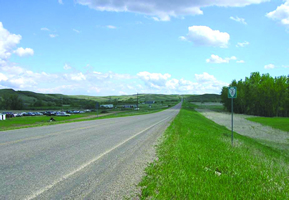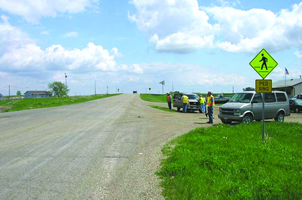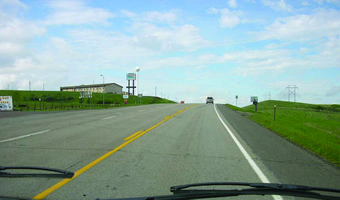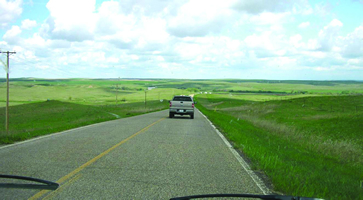U.S. Department of Transportation
Federal Highway Administration
1200 New Jersey Avenue, SE
Washington, DC 20590
202-366-4000

| < Previous | Table of Content | Next > |
Roads: existing two-lane rural tribal roads |
|||
|---|---|---|---|
| Planned Improvements: |
|
||
| Environment: | x urban | suburban | x rural |
| Owner: | Standing Rock Sioux Tribe, Bureau of Indian Affairs, North Dakota DOT, South Dakota DOT | ||
| Road Safety Audit | |||
| Date of RSA: | 22-24 May 2005 | ||
| RSA Stage(s): | x design stage | RSA of existing roads | |
| RSA team: | staff from the Standing Rock Sioux Tribe, Federal Highway Administration (North Dakota and South Dakota Field Offices), North Dakota DOT, South Dakota DOT, Bureau of Indian Affairs, North Dakota State University, Northern Plains TTAP, and Opus Hamilton | ||
PROJECT BACKGROUND:
The Standing Rock Sioux Tribe (SRST) reservation in North and South Dakota extends over 2.3 million acres, with an extensive rural road network of BIA roads (about 200 miles) and county and state roads (about 1,100 miles). The reservation roads connect the reservation’s communities to each other and to the tribal administrative center in Fort Yates, ND. They also serve through traffic, and provide access to the Tribe’s two casinos on Highway 24 near Fort Yates, ND (Prairie Knights Casino) and Highway 12 near Mobridge, SD (Grand River Casino).
At the time of the RSA, the Standing Rock Sioux Tribe was actively pursuing improvements to transportation infrastructure on the reservation. Under the SRST Transportation Department, the Tribe had embarked on a long-range program to upgrade community transportation facilities, including streets, sidewalks, street lighting, and storm sewers. The financing for this long-range program, which was expected to cost $26.5 million, involved the innovative use of government, tribal, and borrowed funds.
In addition to planning and implementing these improvements, the Tribe maintained its extensive road network using its own funds as well as funding from sources such as the BIA. Maintenance of tribal roads was a sensitive topic, since funding for maintenance involved an extensive government allocation effort that limited the amounts available to reservations. At the same time, road maintenance was viewed as an important responsibility that directly affected tribal efforts to build a cohesive reservation community and promote economic activity. Maintenance of the roads on the SRST reservation was a challenge due to their extent (connecting a population of about 9,000 spread over 850,000 acres) and the impacts of the Northern Plains environment (winter road conditions, frost damage, and variations in the underlying water table). Although the SRST reported that it fully utilized available government funds and its own funds, the RSA team observed multiple maintenance-related issues on reservation roads, which are summarized as Issue 1 in TABLE A.11.
Roads studied during this RSA included ND 24 and Highway 1806 (part of BIA 3), US 12, and community access roads. Typical reservation roadways are shown in FIGURE A.13. The RSA team drove these roads to identify safety issues associated with road geometry, traffic operations, and maintenance. Although bridge inspection is not a usual part of the RSA process, the RSA team was asked to observe possible maintenance issues associated with a bridge on BIA 3 at Four-Mile Creek. RSA findings associated with the bridge were included in the RSA report.
 |
 |
| BIA3 at intersection with ND24 south of Fort Yates, ND | BIA 3 / Hwy 1806 in Kenel, SD |
 |
 |
| US 12 at Grand River Casino (left), near Mobridge, SD | BIA 44 west of Mahto, SD |
FIGURE A.13 VIEWS OF RSA SITES (STANDING ROCK SIOUX TRIBE RSA)
KEY RSA FINDINGS AND SUGGESTIONS:
The key findings and suggestions of the RSA are summarized in TABLE A.11.
| SELECTED SAFETY ISSUE (Number and Description) |
RISK RATING | SUGGESTIONS | |
|---|---|---|---|
| 1 | Road Maintenance: Limited maintenance on reservation roads contributes to poor pavement conditions and concern regarding bridge stability. | B to D |
|
| 2 | Access to Grand River Casino: Drivers turning into and out of the Grand River Casino may interfere with crossing, opposing, and following traffic on US12. | D |
|
| 3 | BIA 31 and ND 24 (School Frontage): Driver workload is potentially high near the intersection of BIA 31 and ND 24, which accommodates local, school, and through traffic. | B to D |
|
| 4 | BIA 3 and Highway 1806 (Kenel): Vehicle and pedestrian traffic may interfere with through traffic on BIA 3 through Kenel. | B to D |
|
| 5 | Hwy 1806 and US 12 (Jed’s Landing): Driver workload is potentially high at the intersection, which accommodates high turning volumes and high speeds. | C |
|
| 6 | BIA 3 and ND 24: Left-turning vehicles may obstruct through vehicles at highway intersection on a horizontal curve. | A |
|
KEY LESSONS LEARNED:
The RSA team effectively combined disciplines, and included experts with relevant specialist knowledge. The core disciplines that must be represented on any RSA team are traffic operations, geometric design, and road safety. Beyond these core requirements, the Standing Rock RSA team included members with a range of backgrounds and specialties, including State DOT members, a member with specialist knowledge of pavement maintenance issues, and members familiar with issues associated with tribal policies, practices, and conditions. This combination of backgrounds and skills contributed to the Team’s understanding of the issues and constraints unique to this RSA.
See also the discussion of “Key Factors for Success” and “Lessons Learned” in the main text.
| < Previous | Table of Content | Next > |
